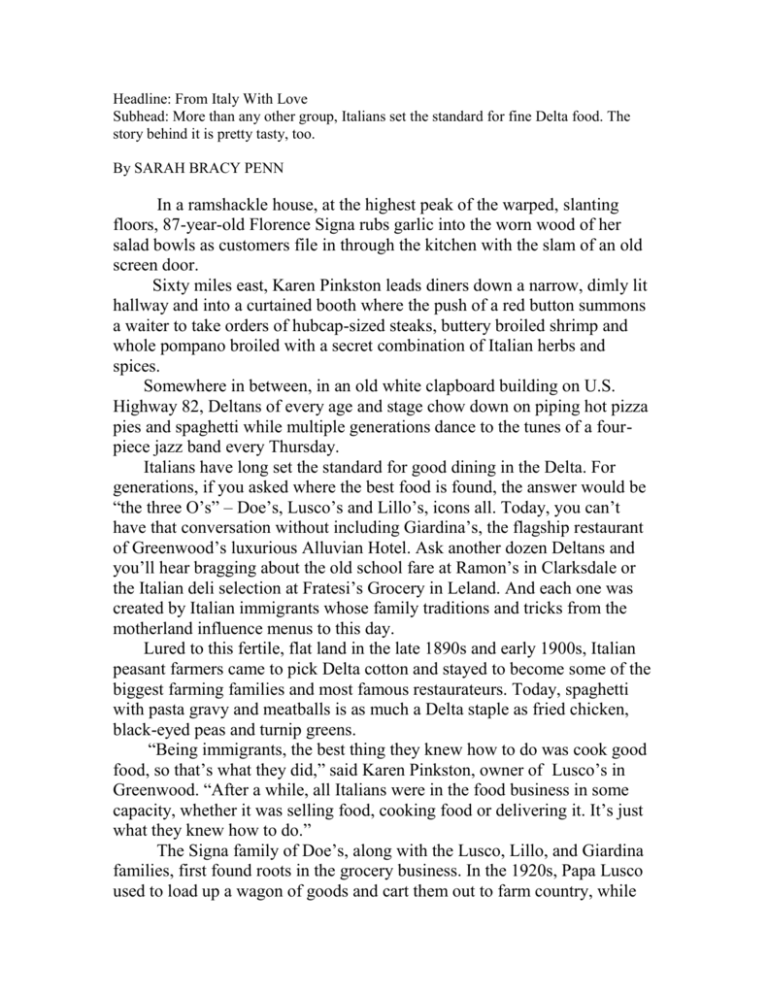DOCX - Mississippi Press Association
advertisement

Headline: From Italy With Love Subhead: More than any other group, Italians set the standard for fine Delta food. The story behind it is pretty tasty, too. By SARAH BRACY PENN In a ramshackle house, at the highest peak of the warped, slanting floors, 87-year-old Florence Signa rubs garlic into the worn wood of her salad bowls as customers file in through the kitchen with the slam of an old screen door. Sixty miles east, Karen Pinkston leads diners down a narrow, dimly lit hallway and into a curtained booth where the push of a red button summons a waiter to take orders of hubcap-sized steaks, buttery broiled shrimp and whole pompano broiled with a secret combination of Italian herbs and spices. Somewhere in between, in an old white clapboard building on U.S. Highway 82, Deltans of every age and stage chow down on piping hot pizza pies and spaghetti while multiple generations dance to the tunes of a fourpiece jazz band every Thursday. Italians have long set the standard for good dining in the Delta. For generations, if you asked where the best food is found, the answer would be “the three O’s” – Doe’s, Lusco’s and Lillo’s, icons all. Today, you can’t have that conversation without including Giardina’s, the flagship restaurant of Greenwood’s luxurious Alluvian Hotel. Ask another dozen Deltans and you’ll hear bragging about the old school fare at Ramon’s in Clarksdale or the Italian deli selection at Fratesi’s Grocery in Leland. And each one was created by Italian immigrants whose family traditions and tricks from the motherland influence menus to this day. Lured to this fertile, flat land in the late 1890s and early 1900s, Italian peasant farmers came to pick Delta cotton and stayed to become some of the biggest farming families and most famous restaurateurs. Today, spaghetti with pasta gravy and meatballs is as much a Delta staple as fried chicken, black-eyed peas and turnip greens. “Being immigrants, the best thing they knew how to do was cook good food, so that’s what they did,” said Karen Pinkston, owner of Lusco’s in Greenwood. “After a while, all Italians were in the food business in some capacity, whether it was selling food, cooking food or delivering it. It’s just what they knew how to do.” The Signa family of Doe’s, along with the Lusco, Lillo, and Giardina families, first found roots in the grocery business. In the 1920s, Papa Lusco used to load up a wagon of goods and cart them out to farm country, while Mama Lusco would stay behind at the store to serve lunch for businessmen downtown, Pinkston said. Eventually, the store became a restaurant. Similar transformations took place in many Italian groceries. What started as a plate lunch for a few men led to daily herds of hungry customers, all eager for a little taste of Italy. The Delta Italians had made it—they found their forte, and it is there they have remained. Just as their ancestors did on the tough terrain of the Italian countryside, Lusco’s, Lillo’s, Doe’s and Giardina’s all lined shoulder to shoulder, gritting their teeth, straining their muscles and tilling the soil that would sprout the restaurant industry in the Delta. These longstanding establishments have endured massive floods and devastating fires and new ownership, yet they continue to thrive. So do the familiar faces inside. A date with potatoes Take the 87-year-old matriarch of Doe’s Eat Place, Florence Signa. She has worked every job in the joint—waitress, hostess, cashier and cook. But her first night on the job was more of an accident. Flo’s boyfriend called her one night —“We had only been dating a few months,” she said — and cancelled a movie date. But Frank “Jughead” Signa had another plan in mind. “’Can you come fry potatoes tonight?’ he asked me. I thought, ‘What kind of date is this, frying potatoes?” Flo said, chuckling. That night led to many more spent in the crowded kitchen of the Greenville landmark, where the sloping floors were never repaired after the big flood of 1927 and the side entrance is locked by a cutlet knife shoved between the dark stained wooded door and its frame. Flo was wooed by Jughead in that very kitchen, watching him shuck raw oysters through an open window while she flipped sizzling potatoes in her frying pan. A year later, they married. Flo knew taking on the Signa name meant lifelong dedication to Doe’s Eat Place. What she didn’t know, however, is just how many people she’d touch there. It’s been 66 years since she began. She’s passed on the potatoes to another cook, but she still works three nights a week at the Greenville gem. Jughead died 17 years ago, but Flo finds comfort in this kitchen, even without him there slurping up two oysters for every three he’d crack open. From her perch at the highest peak of the kitchen’s slanting foundation, she can observe all of the happenings of the restaurant. Straight ahead, through the rising steam of simmering tamales and past the potato cook, she can peer into the main dining area. A quick cut of her eyes to the right and there’s the side dining room, which was once the Signas’ bedroom when they still used half of the restaurant as their home. “This here. This is my spot,” she said, standing at the kitchen island, her hands gently rubbing a spot on the faux wood counter that has been worn down from handling countless wooden bowls through countless decades. Heinz tomato ketchup bottles filled with olive oil and a large tin saltshaker sit before her. “They tried to move me to the corner of the kitchen, but I couldn’t do it,” she said. “I couldn’t just turn my back on all these people. I like to see them and talk to them while I work.” Behind closed curtains Over at Lusco’s in Greenwood, a list of menu specials in swirly cursive is inscribed on a whiteboard propped on an easel. These Lusco family recipes are served exclusively in March of each year, marking the anniversary of the red brick storefront on Carrollton Avenue. In its 80 th year, Lusco’s still stands as one of the most acclaimed eat places in the Delta. But in 1933, Papa Lusco probably never imagined the place of his name would become such an attraction for people in search of food that is always good and atmosphere that is arguably even better. In the early days, Mama Lusco’s cooking attracted Greenwood businessmen to the table. But what really brought in the flocks was Papa’s homebrew, served secretly during the Prohibition era. Although Lusco’s appeared as a fully functioning grocery, a whisper of the password opened the rear door, revealing a hallway of booths, each sealed off with a curtain. It was in those private dining booths that the legend of Lusco’s was born. The enticing lure of secrecy is perhaps what keeps customers coming after all these years. Each night, folks from across the Delta enter armed with their wine and liquor enveloped in brown paper sacks. They are led down the mint green hallway flanked by framed newspaper clippings and Lusco family portraits. Maybe they are seated in booths 5 or 10, the “Lovers’ Booths” that have seen couples get engaged. Or perhaps booth 3, which once served as Papa Lusco’s daughter Marie’s bedroom after she was married. But what is it that makes the privacy so alluring? Pinkston believes her customers yearn for the thrilling freedom that comes with being able to say and do whatever you please behind those drawn curtains. “But people forget you can hear every word they’re saying,” Pinkston said. The mystique of Lusco’s is further enhanced by the cuisine. A blend of Italian tradition and New Orleans flair, the menu boasts everything from penne rigate pasta topped with red meat sauce to their famous crisp battered onion rings and fried shrimp. You can’t forget the steaks dressed with Crabmeat Karen, with spinach soufflé served alongside. But the single dish that sets Lusco’s apart is a true New Orleans delicacy—pompano. The story goes that a loyal customer had a taste of the delicate white fish in the Crescent City, and returned to Greenwood insisting Lusco’s serve it. The first pompano were brought up from the Gulf on a Greyhound bus, and a longtime cook broiled it whole and served it up in a lake of lemon butter sauce. Today, it remains one of Lusco’s most popular dishes. Dance night in the Delta It doesn’t matter how fast you’re speeding down the highway through Leland, you can’t miss the enormous white-and-black sign that reads: Lillo’s Family Restaurant. The authentic Italian-American restaurant was formerly an American Legion hall, its simple white clapboard exterior and black shutters in no way alluding to the entertainment to be had within. Upon entering, diners are hit with a heavy smell of garlic. Family snapshots and portraits from the St. Joe homecoming dance litter the cashier’s counter. Candles flicker to the rhythm of a dozen ceiling fans, and there is a certain coziness to the wood paneled walls. On most nights, owner Wesley Keen and his crew serve up broiled catfish and shrimp supreme in lemon butter sauce, as well as Italian classics eggplant parmesan and spaghetti with pasta gravy. But on Thursday nights, a Delta tradition has taken off. For twenty years, the tables have been pushed to the walls and the Lillo’s jazz band plays out tunes as couples of all ages shuffle across hardwood floors. This is Thursday. This is Dance Night. From 60 miles off, they come. Whether they can dance or not, they come. It is not unusual for 100 people to show up. “I’ve got one lady who calls me if they’re not coming,” said Keen. “She’s 91 or 92 and still dancing. Nobody can believe she’s that old.” It all began when a local musician and longtime customer asked to play at the restaurant. Only one of the original four band members is still around, but the Lillo’s faithful remember Bubba Hubba, Dr. Bill Booth, and, of course, the eccentric old pianist, Boogaloo. “He used to say he was married to Tina Turner,” Keen said. “You’d have to fine tune him. He’d either be knee walking drunk or we’d have to put a little liquor in him.” Hanging on the wall is a portrait of Jimmy and Conchetta Lillo, the first generation who opened Lillo’s as a grocery in the summer of 1948. The Lillos claimed to be the first to introduce pizza to the Delta, and it remains one of the most popular items on the menu. “Back then, they would ask, ‘Do you want a pizza pie?’ And customers would ask, ‘Piece ‘a pie? What kind you got?’” Keen said. To Napa, New Orleans and back Giardina’s began as a grocery-turned-restaurant on Park Avenue. Hailing from the tiny Sicilian town of Cefalu, the Giardina family quickly found their place serving steaks and seafood in private booths. Local rumor has it that Giardina’s curtained booths are inspired by those of Lusco’s. The restaurant has since relocated to the Alluvian Hotel in downtown Greenwood. Once owned by businessman Fred Carl, it is the premier fine dining restaurant of the area. Carl did not have to go far to find a chef. Enter 29-year-old Lee Leflore, Carl’s Delta-raised nephew and a descendant of the Choctaw chief for whom Leflore County is named. Leflore’s only been the chef at Giardina’s for nine months, but he has had a lifetime of training in his Italian family’s kitchen. He began working at the restaurant at 18, but has since ventured across the country studying the ins and outs of the fine dining experience. After receiving a degree in hospitality management at Ole Miss, spending a year at the Culinary Institute of America in Napa Valley and a stint in Emeril Lagasse’s New Orleans kitchen, Leflore was called back to the Delta. Like most Italians in the Delta, marinara is in his blood. His family, the Barrancos, reserved pasta for Sunday meals. He remembers hearty dinners of eggplant parmigiana and Italian sausage, always served alongside homemade pasta and dressed with Barranco pasta gravy. “[Pasta gravy]’s more of a Sicilian thing. It’s really hard to say why. It’s a gravy because it’s so thick. It’s not like a thin tomato sauce or marinara sauce,” said Leflore. Regardless of its unknown etymology, pasta gravy has become a Delta tradition all its own. In years past at the annual Italian Festival of Mississippi in Cleveland, where convicts dressed in emerald green and ecru stripes stir vats of pasta gravy with canoe paddles, all of the great Italian families duked it out for the best pasta gravy recipe. When it comes to Giardina’s menu, pasta gravy is the dressing of crisp calamari and house-made Italian sausage, as well as the final touch to angel hair pasta and veal parmigiana. Other family classics on the menu include Jojo’s lasagna and Camille’s bread, named for Leflore’s grandmother and great-grandmother, respectively. Traditions run deep for Giardina’s Restaurant. Delta Italians have come a long way since the late 19th century. The majority of Delta Italians come from two regions—Ancona and Sicily. They came by the boatload into either Ellis Island or the Port of New Orleans, where plantation owners immediately hired the eager immigrants as sharecroppers. The work on the plantations was tough—but not as daunting as the labor in Italy. “In Italy, they’d line ‘em up across the field and they would shovel across it all day long ‘til dark and they’d walk back. That’s how bad it was over there,” said third generation Delta Italian Sandy DeAngelo. In time, Italians would own some of the biggest farms and restaurants in the Delta. But it wasn’t always easy being an immigrant entrepreneur in early 20th century Mississippi. Discrimination found its way to Chinese, Lebanese and Italians alike. Steve Fratesi, a fourth-generation Delta Italian, remembers what it was like to feel different. “Back then, we didn’t want to be Italian,” Fratesi said. In fact, most Delta Italians can speak only a few words in their ancestral language. At the time, it seemed assimilation paved the road to success. But now, the prosperous Delta Italians are enormously proud. And it shows on menus like the one at Giardina’s. Despite his fancy culinary training, Leflore has left the menu untouched. Well, almost. “My dying meal would be pasta Sunday,” he said. “Rigatoni is my favorite. I put it on the menu, and it’s the only thing I’ve added.” -30-







![Kwadijk-Deltatechnology presentation [Compatibiliteitsmodus]](http://s2.studylib.net/store/data/005765666_1-8750ea686d0c834b2bb5a5055d5c4a69-300x300.png)
